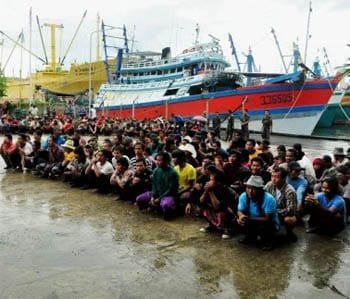
Hundreds of fishermen, mostly from Myanmar and Thailand, were rescued from a remote Indonesian island in 2015 after they were found to be working in slavery-like conditions for Thai fishing company Pusaka Benjina Resources.
‘Seafood caught illegally or under conditions of modern slavery is laundered by mixing it with legally caught fish before it enters the supply chain.’
Labor abuses, including modern slavery, are ‘hidden subsidies’ that allow distant-water fishing fleets to remain profitable and promote overfishing, new research from the University of Western Australia and the Sea Around Us initiative at the University of British Columbia has found.
The Global Slavery Index estimates that at least 40 million people are trapped in modern slavery, defined as any exploitation that a person cannot avoid, refuse or leave because of threats, violence, coercion, abuse of power or deception. It is particularly widespread in the textile, agriculture, construction and fisheries sectors, as well as in the sex industry and in forced marriages.
By combining fisheries data from the Sea Around Us initiative at UBC with country-level data on modern slavery, the researchers found that countries whose fleets rely heavily on government subsidies, fish far away from home ports, and fail to comprehensively report their actual catch, tend to fish beyond sustainable limits and are at higher risk of labor abuses.
“Crews on vessels from China, Taiwan, Thailand, South Korea and Russia are particularly at high risk because of a lack of regulatory oversight in those countries combined with the complexities of jurisdiction at sea. This makes it easier to force people to work excessively long hours, often under appalling conditions, to extract as much fish as possible in exchange for a low – or zero – pay,” said David Tickler, lead author of the study from the University of Western Australia.
With global marine fish catches declining at a rate of 1.2 million tonnes per year since the mid-1990s, the only way many industrial countries’ fleets have been able to remain profitable is by receiving government subsidies. However, labor costs can typically only be lowered by reducing worker pay and conditions.
“The lack of control over these boats makes them a fertile ground for labor abuses, as well as other crimes including illegal fishing. It also facilitates transshipment, where catches of multiple fishing vessels are often combined before landing. Thus, seafood caught illegally or under conditions of modern slavery is laundered by mixing it with legally caught fish before it enters the supply chain,” said Daniel Pauly, co-author of the study and the principal investigator of the Sea Around Us initiative at the UBC’s Institute for the Oceans and Fisheries.
This is how ‘low slavery risk’ markets, such as the US, the EU and Australia, end up consuming seafood that may have been caught by modern slaves.
“While domestically the average slavery risk in the United States is low, the U.S. accounts for about 14 per cent of global seafood imports and those imports have a slavery risk 17 times higher than fish caught by U.S. fleets domestically,” said Jessica Meeuwig, Director of the Marine Futures Lab at UWA and co-author of the study. “Since imported and U.S.-fleet caught fish are combined in local markets, the seafood available to domestic consumers in the U.S. is eight times more likely to have been produced or processed with modern slavery.”
[Adapted from a University of British Columbia news release]
| From “Modern slavery and the race to fish,” published in Nature Communications, November 7, 2018 Marine fisheries are in crisis, requiring twice the fishing effort of the 1950s to catch the same quantity of fish, and with many fleets operating beyond economic or ecological sustainability. A possible consequence of diminishing returns in this race to fish is serious labor abuses, including modern slavery, which exploit vulnerable workers to reduce costs. Here, we use the Global Slavery Index (GSI), a national-level indicator, as a proxy for modern slavery and labor abuses in fisheries. GSI estimates and fisheries governance are correlated at the national level among the major fishing countries. Furthermore, countries having documented labor abuses at sea share key features, including higher levels of subsidized distant-water fishing and poor catch reporting. Further research into modern slavery in the fisheries sector is needed to better understand how the issue relates to overfishing and fisheries policy, as well as measures to reduce risk in these labor markets. |


